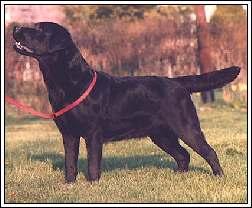 |
 |
 |
 |
 |
 |
 |
 |
 |
| |
|
|
| |
|
|
|
|
|
|
|
| |
 |
 |
 |
| |
 |
 |
FCI
Standard for Labrador Retrievers
The Federation Cynologique Internationale (FCI)
is the World Canine Organization. Eighty countries throughout
the world are part of this organization (the United
States of America is not among them). The FCI recognizes
330 breeds. Each of them is the "property" of a specific
country. The "owner" countries of the breeds write the
standard of these breeds (description of the ideal type
of the breed) which all member countries use as their
breed standard and the reference on which their judges
base themselves when judging shows held in FCI member
countries.
LABRADOR RETRIEVER
GENERAL APPEARANCE: Strongly built, short coupled, very
active; broad in skull; broad and deep through chest
and ribs; broad and strong over loins and hindquarters.
CHARACTERISTICS: Good tempered, very agile. Excellent
nose, soft; keen lover of water. Adaptable, devoted
companion.
TEMPERAMENT: Intelligent, keen and biddable, with a
strong will to please. Kindly nature, with no trace
of aggression or undue shyness.
HEAD & SKULL: Skull broad with defined stop; clean cut
without fleshy cheeks. Jaws of medium length, powerful
not snipey. Nose wide, nostrils well-developed.
EYES: Medium size, expressing intelligence and good
temper; brown or hazel.
EARS: Not large or heavy, hanging close to head and
set rather far back.
MOUTH: Jaws and teeth strong with a perfect, regular
and complete scissor bite; i.e., upper teeth closely
overlapping lower teeth and set square to the jaws.
NECK: Clean, strong, powerful, set into well-placed
shoulders.
FOREQUARTERS: Shoulders long and sloping. Forelegs well-boned
and straight from elbow to ground when viewed from either
front or side.
BODY: Chest of good width and depth, with well sprung
barrel ribs. Level topline. Loins wide, short coupled
and strong.
HINDQUARTERS: Well developed not sloping to tail; well
turned stifle. Hocks let down, cowhocks highly undesirable.
FEET: Round, compact, well-arched toes and well-developed
pads.
TAIL: Distinctive feature, very thick towards base,
gradually tapering towards tip, medium length, free
from feathering, but clothed thickly all round with
short, thick, dense coat, thus giving "rounded" appearance
described as "Otter" tail. May be carried gaily, but
should not curl over back.
GAIT/MOVEMENT: Free, covering adequate ground; straight
and true in front and rear.
COAT: Distinctive feature, short dense without wave
or feathering, giving fairly hard feel to the touch;
weather resistant undercoat.
COLOUR: Wholly black, yellow or liver/chocolate. Yellows
range from light cream to red fox. Small white spot
on chest permissible.
SIZE: Ideal height at withers: dogs 56 - 57 cms (22
- 22.5 ins); bitches 54 - 56 cms (21.5 ins).
FAULTS: Any departure from the foregoing points should
be considered a fault and the seriousness with which
the fault should be regarded should be in exact proportion
to its degree.
NOTE: Male animals should have two apparently normal
testicles fully descended into the scrotum.
Approved by the General Assembly on the 23rd and 24th
June 1987 in Jerusalem |
 |
|
 |
 |
Navigate
the NLRC Website |
 |
 |
 |
 |
 |
 |
 |
 |
 |
|
|
 |
 |
 |
 |
 |


|
|
 |
 |
 |
 |
 |
 |
 |
 |
 |
|
|
 |
 |
 |
|
|
This site is "optimized" for viewing at 800
x 600 pixels; this is not a browser setting, but a system setting.
© 2000-present National Labrador Retriever Club, Inc. All rights
reserved.
Articles, photos and graphics may not be reproduced, by any means,
without written permission from
the NLRC, Inc.
|
|